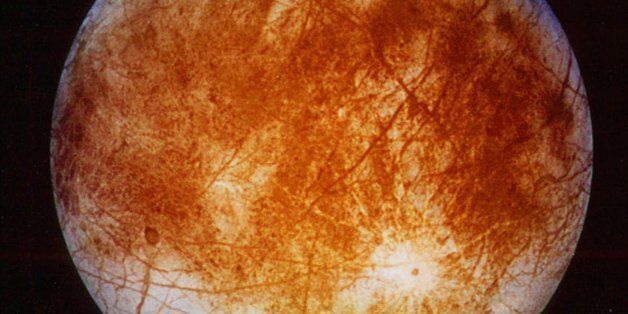This week we are one step closer to understanding a world in our solar system that I believe has the best chance of supporting life beyond our own planet. NASA has just announced details about what instruments a space probe to Jupiter’s moon Europa will carry when it makes multiple flybys in the next decade.
I couldn’t be more excited to be the project scientist of this mission. I first learned of Europa as a kid who made planets out of tennis balls covered in construction paper and masking tape and hung them from my bedroom ceiling on Long Island. In 1979, the twin Voyager 1 and Voyager 2 spacecraft flew past Jupiter and its moons. Though not the largest moon of Jupiter, Europa was the most enigmatic: Voyager’s pictures showed a maze of dark lines marking the bright icy surface, like a cracked eggshell.
Seeing the first Voyager 2 photos of Europa inspired the famous Carl Sagan to wonder whether the dark bands were mountain-like ridges or valley-like troughs. What do they say about the history of this world? I was fortunate to take Sagan’s seminar course at Cornell University in 1985 and was fascinated by the possibility of a watery ocean within Jupiter’s moon Europa. It was uncertain whether such an ocean would have frozen solid over time or could persist today.
To learn more, NASA sent the Galileo spacecraft past Europa a dozen times while orbiting Jupiter between 1996 and 2002. Galileo images showed Europa’s surface to be crisscrossed by both mountain-like ridges and valley-like troughs. The patterns of the ridges and cracks suggest an ocean below that permits the ice shell to flex and break. Giant bulls-eye-like scars tell of large comets that collided with the moon, the impacts penetrating the icy shell to liquid water below. In places, the surface is broken into city-sized chunks that resemble giant ice floes.
In addition to its strange geology, Europa shows an unusual magnetic signature. The Galileo spacecraft’s magnetic sensors detected a layer beneath Europa’s surface that conducts electricity, betraying an underground saltwater ocean. It’s that ocean that makes Europa particularly fascinating because of the distinct possibility that there could be life in these lightless waters. We don’t expect whales or fish down there, but alien single-celled microorganisms could exist.
Other moons at Jupiter — Ganymede and Callisto — probably have oceans deep within. Saturn’s tiny moon Enceladus spews water into space from geysers. But Europa’s ocean provides the best case for life because it is the most likely to have had all three ingredients for life — water and the elements needed to build organic molecules and chemical energy.
Finding life elsewhere would end our cosmic isolation: if there is life in our own planetary backyard, then life is probably common throughout the universe.
These enticing possibilities are why my colleagues and I have spent 17 years developing a spacecraft mission dedicated to understanding Europa. We will orbit Jupiter, as Galileo did, but this time, focusing in on Europa with dozens and dozens of very close flybys and instruments designed to divine Europa’s history.
It will take at least a decade to go from blueprints to getting data back. There’s a kid somewhere now, hanging model planets in his bedroom, who will help decipher whether Europa is everything I hope it is.
© Zócalo




